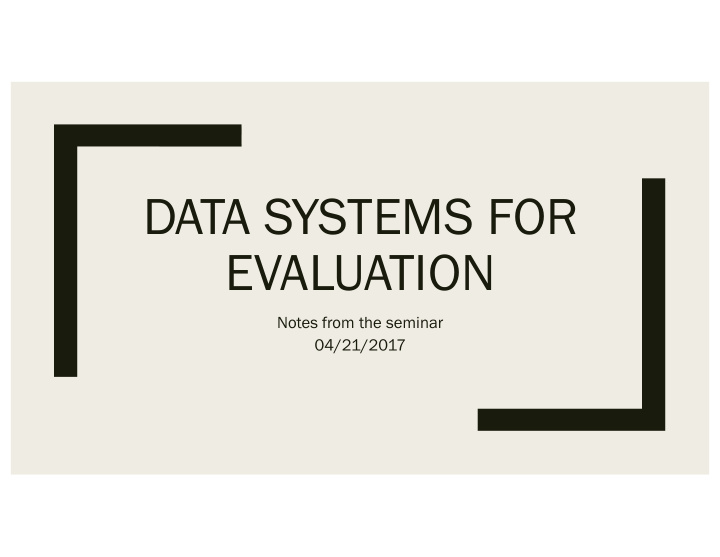



DATA SYSTEMS FOR EVALUATION Notes from the seminar 04/21/2017
Presenters ■ Brooke Tafoya, New Day Operations Director ■ Juliann Salinas, Enlace Comunitario Development Director ■ Chris Erwin, Evaluation Lab Graduate Assistant
Brooke Tafoya, New Day ■ Initially there were many data formats and methods – What kinds of database systems were out there and what could help us? ■ Started about a year ago – Researching – Used EMR BEAR for their db ■ Not flexible enough ■ Consider the environments in which your system will be used ■ Needed the system to be fast (response to crisis phone calls)
Brooke ■ Considerations for new systems – How flexible is the system? – What is the cost is the system? What are the costs of the logins? – Who takes the lead? ■ Hierarchical structure of db must be addressed – Have dba in on the decision-making process – How are conventions developed and how easily are they communicated to trainees? – How easy is it to generate reports from the system?
Brooke ■ Preparation – Streamline forms and surveys ■ Eliminate duplicates, if possible – Consider time-savings ■ Get input from staff and end-users – Establish realistic timeline ■ Don’t start the transition or development during heavy work seasons – Consider ease of use (training investments) – Adapting systems can be fantastically costly – Ensure that identifiers are easily identified
Apricot ■ FEUI – Apricot – Generates reports from db very quickly – Data reports can show inconsistencies in data collection and management ■ These can be time, and cost-saving measures
Juliann Salinas, Enlace Comunitario
What do we want to know from data? How to What are the develop logic effects of our model programs?
What are we ■ Brainstorming a database – Laying out the data collection doing? processes – Establishing reasons for the collected data – How do we need to query? (report generation) ■ How do we sort – Tracking costs and billing – Identifying the necessary relationships in the databases – Share demos with staff (end-users) – Consider a db that will autofill duplicate information (repeated or overlapping forms)
■ What is Tableau? Chris Erwin – Used for data visualization ■ Pros for Program Evaluation – User-friendly – Intuitive – Hands-on – Stories and dashboards are powerful – Free for non-profit and academic endeavors ■ Cons for program evaluation – Lacks analytical power ■ Most statistical analysis should be done with R (or stata) ■ Data from PB&J Family Services – Considering ■ NCFAS ■ PICCOLO ■ PFS
PB&J Family ■ Structure – Surveys Services Data ■ Domains – Fields ■ Scores ■ Data from surveys ported to scrubbing & analysis program – Scrubbed data fed to Tableau – Tableau can generate visualizations from summary statistics which were generated from other program – Tableau talks with google Sheets ■ Google Sheets is not secure (no PII)
Takeaways ■ Tableau is pretty ■ Nice to talk about development processes with other organizations ■ Organizational involvement is necessary for successful rollout of policies ■ Data clarity is important ■ DBA is necessary for maintenance and training ■ Organizations to which organizations cater could benefit from the ideas and outputs from the Evaluation gatherings (meetings) – Getting their data people together with the organizations in order to develop conventions and standards
Recommend
More recommend